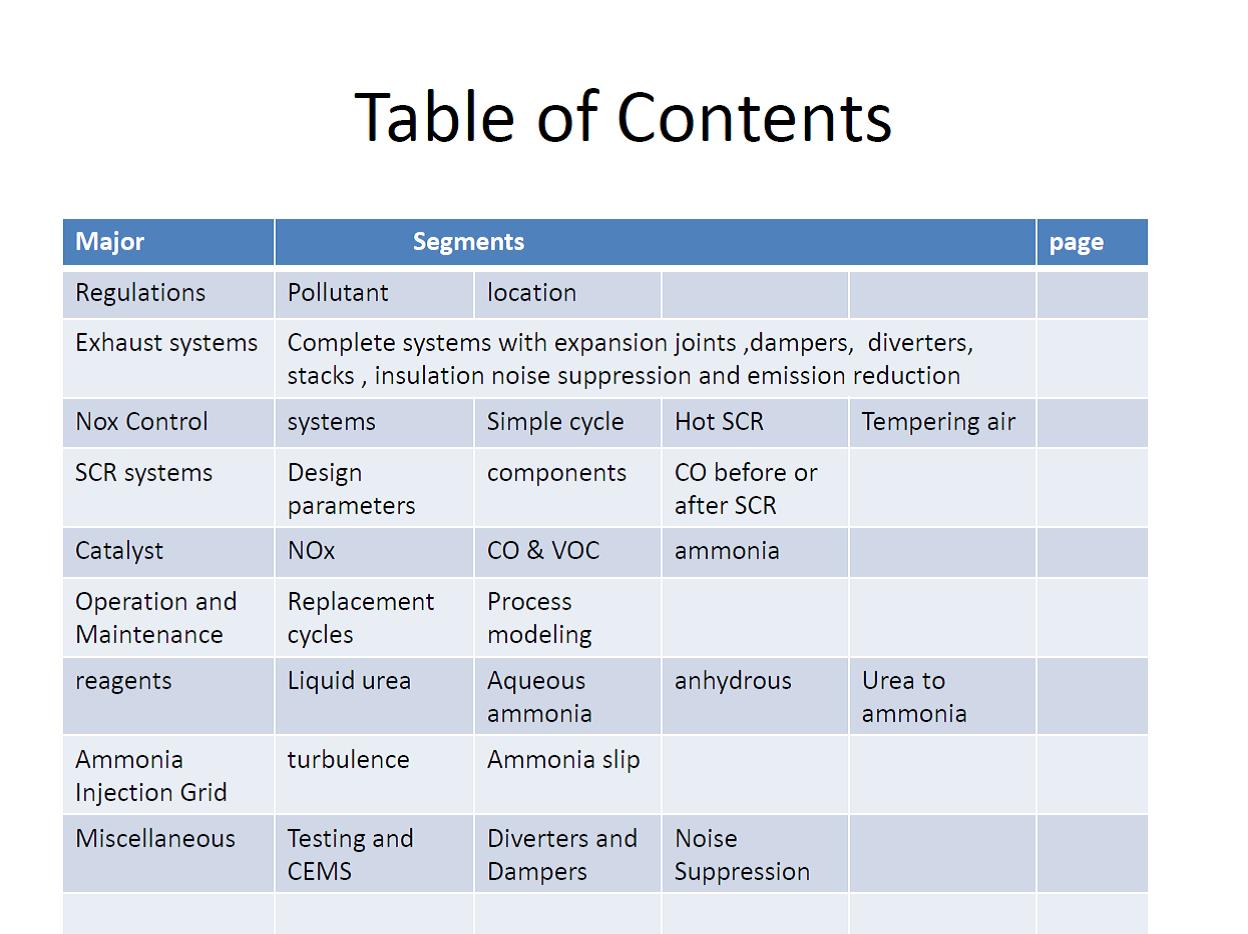
GAS TURBINE AND COMBINED CYCLE DECISIONS
UPDATE
September 2015
McIlvaine Company
TABLE OF
CONTENTS
Total Solutions Hot Topic Hour (August 20) confirms the
Trend toward Greater Outsourcing
Total Solutions Options - Hot Topic Hour August 20, 2015
The discussion of Total Solution
Options was based on a series of power points.
Revision Date:
8/20/2015
Tags:
Total Solutions Options Webinar - Hot Topic Hour August 20, 2015
Speakers and participants in the
Total Solutions Hot Topic Hour on August 20 confirmed that customers want
suppliers to offer a broader scope of design and installation services. More
operation and maintenance support is also needed.
Revision Date:
8/20/2015
Tags:
Gas Turbine
Exhaust and Emissions Control
Highlights of a hot topic hour
webinar on gas turbine exhaust systems including dampers, silencers, catalysts
and other components focused on unmet needs, issues and options.
Revision Date:
8/20/2015
Tags:
McIlvaine, Gas Turbine, Exhaust System
Gas Turbine NOx Reduction Retrofit
Chevron’s Eastridge Cogeneration
Plant near Bakersfield, California, produces steam for thermally enhanced oil
recovery and electricity to the grid. To meet regional NOx emissions rules, two
existing gas turbines needed the addition of selective catalytic reduction (SCR)
for NOx control. This paper discusses the retrofit process from beginning to
end.
Revision Date:
8/19/2015
Tags:
221112 - Fossil Fuel
化石燃料, Chevron, Peerless Manufacturing,
Ammonia, SCR, Catalyst, Retrofit Technology, Cost, DeNOx, USA
Montrose supplies stack testing, consulting, and laboratory services
Montrose has acquired a number
of companies and supplies a whole suite of environmental services.
Revision Date:
8/17/2015
Tags:
221118 - Other Electric Power , 221118 - Other Electric Power , Montrose
Environmental, Monitoring, Testing, Consulting, Total System Solutions
Sulzer SCR Mixing and Other Mixing Equipment
Sulzer has a range of flow
control and treatment products including a mixer which evenly distributes
ammonia in the ductwork prior to an SCR.
Revision Date:
8/17/2015
Tags:
221112 - Fossil Fuel
化石燃料, Sulzer Ltd., Mixer, SCR, NOx Control,
Ammonia Injection
IAPWS Gives Guidance for Monitoring Steam
Purity
Problems caused by mechanical and
vaporous carryover of contaminants in the water to the steam cycle begin with
deposition and corrosion of HRSG tubes and steam-turbine surfaces and can
ultimately lead to material deterioration, performance deterioration, extensive
downtime for removing deposits, and catastrophic failures. This article gives
guidance for monitoring steam purity to avoid these issues.
Revision Date:
8/11/2015
Tags:
221112 - Fossil Fuel
化石燃料, Corrosion, Cycle Chemistry, Sampling,
Combined Cycle Journal
Upgrading Legacy Gas Turbines to Meet Challenging NOx and CO Permit Limits
At the Clark Generating Station
in Nevada, four gas turbines with diffusion flame burners were commissioned
around 1980 and permitted for 103 ppm NOx. The turbines were converted to dry
low NOx combustors and now operate at less than 5 ppm. This article discusses
what is involved in converting to DLN.
Revision Date:
8/3/2015
Tags:
221112 - Fossil Fuel
化石燃料, NV Energy, Low NOx Burner, NOx Emissions
Reduction, Combined Cycle Journal, USA
Managing the Catalysts of a Combustion Turbine Fleet
Historically, many gas plants
have been operated cyclically with extended dormant periods due to high natural
gas prices and a varying demand for the electricity the plant provides. For
plants with an SCR system, stopping and laying up the equipment may accelerate
aging of the catalyst system components, increasing the importance of
inspections and preventative maintenance planning. This article discusses the
process of economically managing a fleet of SCR-equipped gas turbines.
Revision Date:
8/3/2015
Tags:
221112 - Fossil Fuel
化石燃料, Cormetech, SCR, Catalyst, Maintenance,
NOx Emissions Reduction, Power Magazine
Eliminating Feedwater Control Valve Damage with Multi-stage, Multi-path
Flowserve Control Valves
The feedwater control valve
(located downstream of the high-pressure feedwater heaters) performs the
critical function of controlling the feedwater flow rate over a wide range of
service conditions. During startup and shutdown, the feedwater control valve
restricts flow by controlling near the closed position. The pressure drop across
the valve is high, which can cause severe cavitation and noise. Over time,
these severe service conditions will damage a control valve. Even a properly
designed valve will not work well unless it is connected to a correctly sized
actuator. An undersized actuator will cause unstable flow conditions while an
oversized unit has a slow response to input signals. Flowserve has successfully
addressed these issues with specially engineering multi-stage multi-path, or
MSMP, designs. MSMP trim channels the flow through a series of orifices to
reduce the pressure in stages. This prevents cavitation from occurring inside
the valve. The velocity of the feedwater is kept low to prevent erosion of the
valve body and to reduce noise and vibration. MSMP trim is customer-designed
for the full range of service conditions. MSMP trim prevents cavitation when
throttling near the seat but acts like a conventional control valve when
controlling near the full-open position. As the pressure drop across the valve
decreases, the cavitation also decreases and then stops. To maintain flow rate
with decreasing pressure drop, the valve will open further and expose flow paths
without orifices. The orifices are not needed at this flow condition because
cavitation has stopped.
Revision Date:
8/3/2015
Tags:
221118 - Other Electric Power, 221118 - Other Electric Power, Flowserve, Valve,
Actuator, Boiler Feedwater System, Cavitation, Noise, Vibration
The Thursday 70 minute discussion of gas turbine (GT)
emission control and exhaust system options followed the new format. A slide
deck with 100 power points was the road map for the discussion with stops along
the way to cover new options. The road map displayed many options from noise
suppression to ammonia injection.

The stopping points were concentrated on catalysts,
testing, and ammonia injection. The
meeting started with David Couling
of E.ON.
His group of 1,000 engineers in the UK supports the power operations in
many countries. Presently many of the E.ON power plants are facing prospects of
EU regulations on combustion turbines with limits as low as 5 ppm. The problem
with meeting these regulations at the 15,000 to 20,000 MW of combustion turbine
systems which E.ON operates in the region is the tight space. So David was
interested in what the various suppliers would recommend to make the
installations more compact.
A number of catalyst, components and testing experts
provided details on the newest technology and how it may influence which option
to take.
§
Should you use high temperature catalyst or tempering air with a simple cycle
arrangement?
§
What catalyst configuration is best?
§
How different are the formulations between one catalyst supplier and another?
§
How do you deal with increased sulfur and other contaminants?
§
Can you combine CO and NOx conversion in one catalyst?
§
What is the best reagent choice? Anhydrous, aqueous or urea conversion to
ammonia?
§
How important is CFD modeling ahead of final engineering?
A number of people weighed in on these issues.
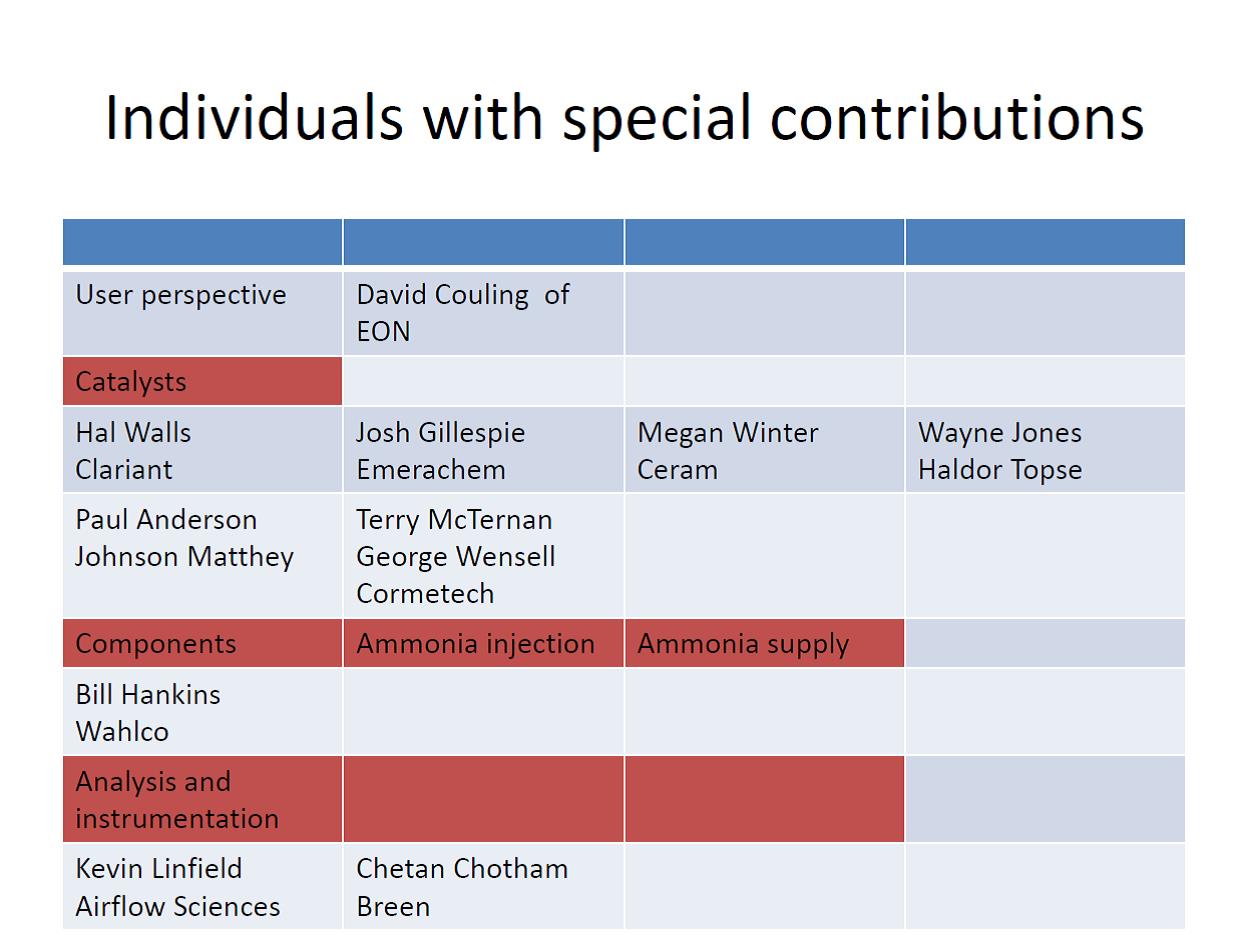
Mitsubishi
has installed more than 600 SCR systems for gas turbines.
Catalyst
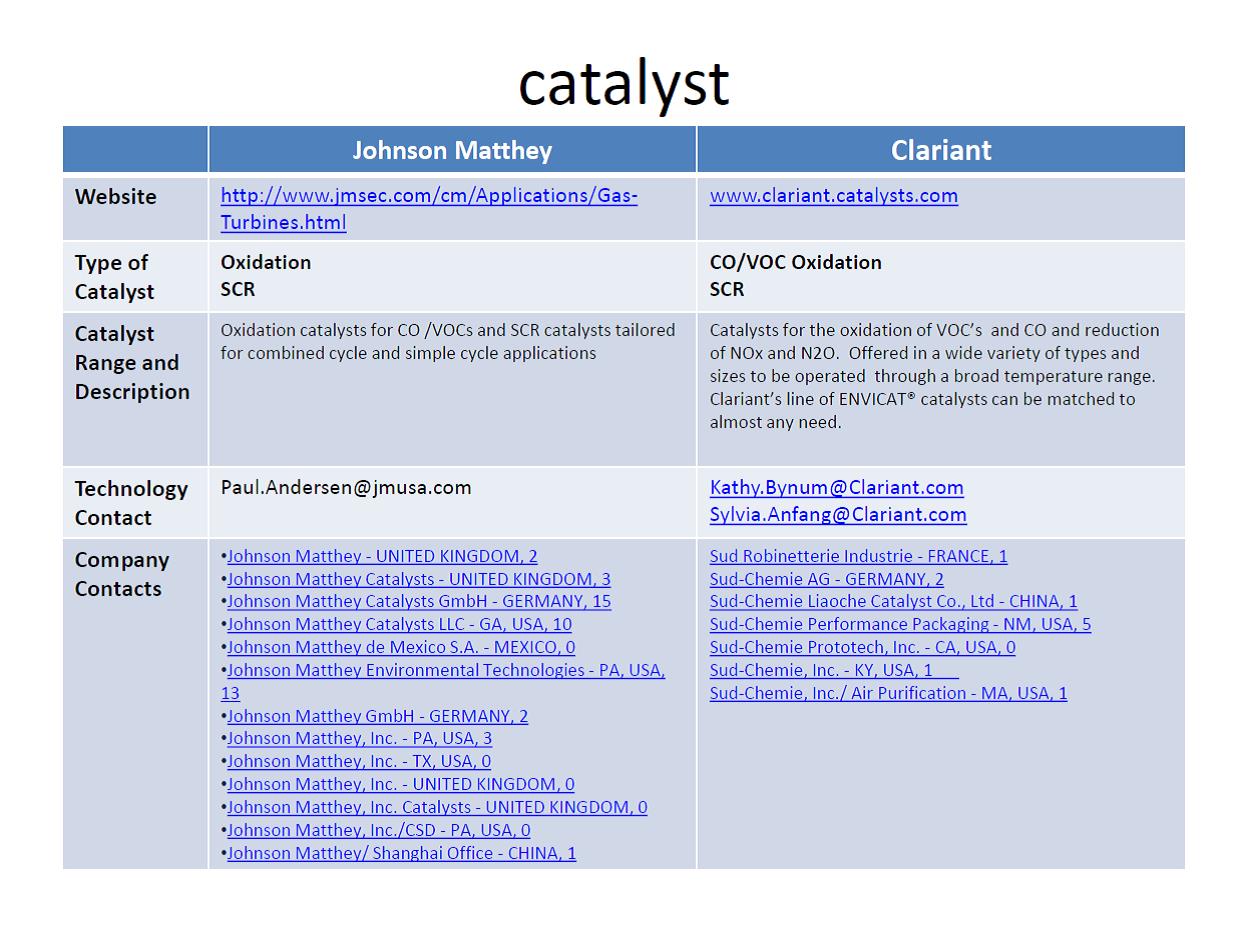
Johnson Matthey
uses a compact honeyocmb catalyst which will be attractive to those European GT
owners who must retrofit catalytic units into existing systems. Their oxidation
catalyst efficiency ranges from 90 to 95 percent depending on the the gas
temperature.
Clariant
makes the raw material and the catalyst. Their high temperature catalyst is
durable and efficient at temperatures in excess of 600°C.
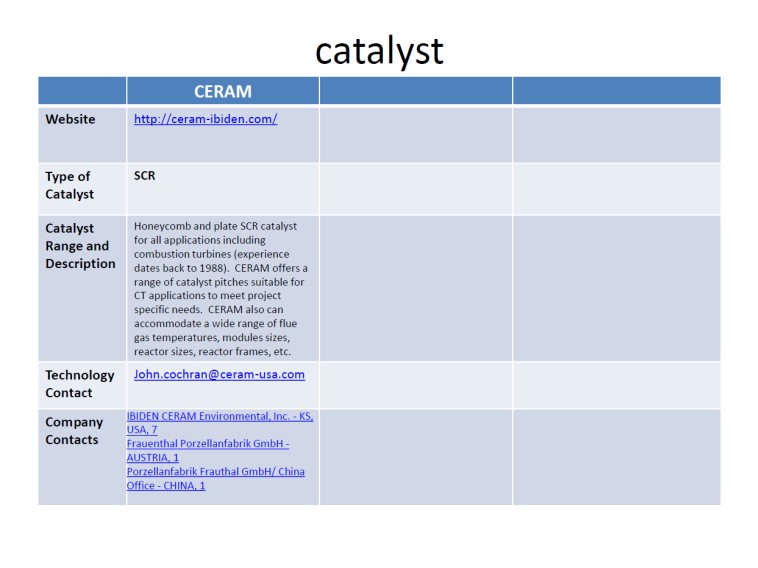
Ceram
can customize module size. This is an important feature for retrofit
applications in Europe where space is premium.
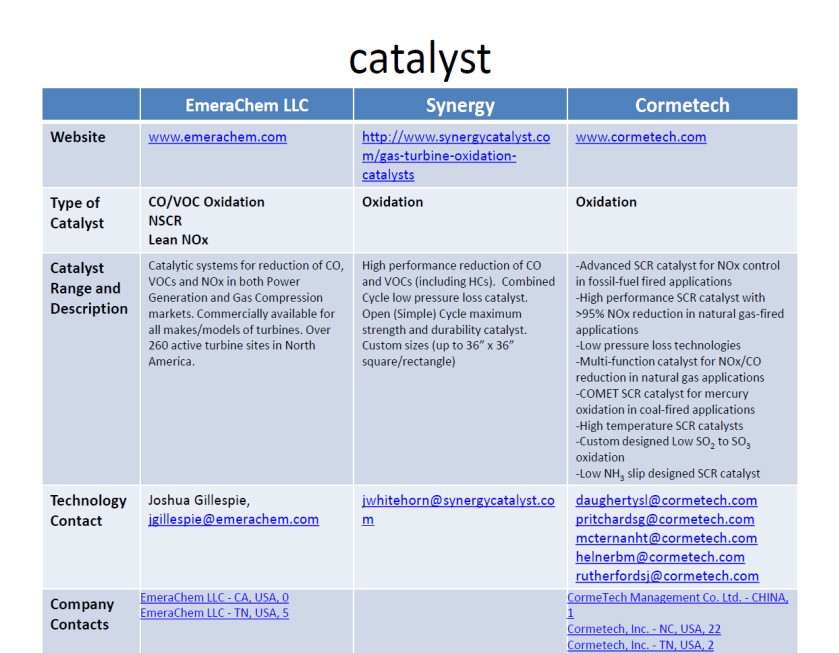
Cormetech
is a major supplier of gas turbine catalysts in the U.S., China and Europe.
Emerachem
also has many installations.
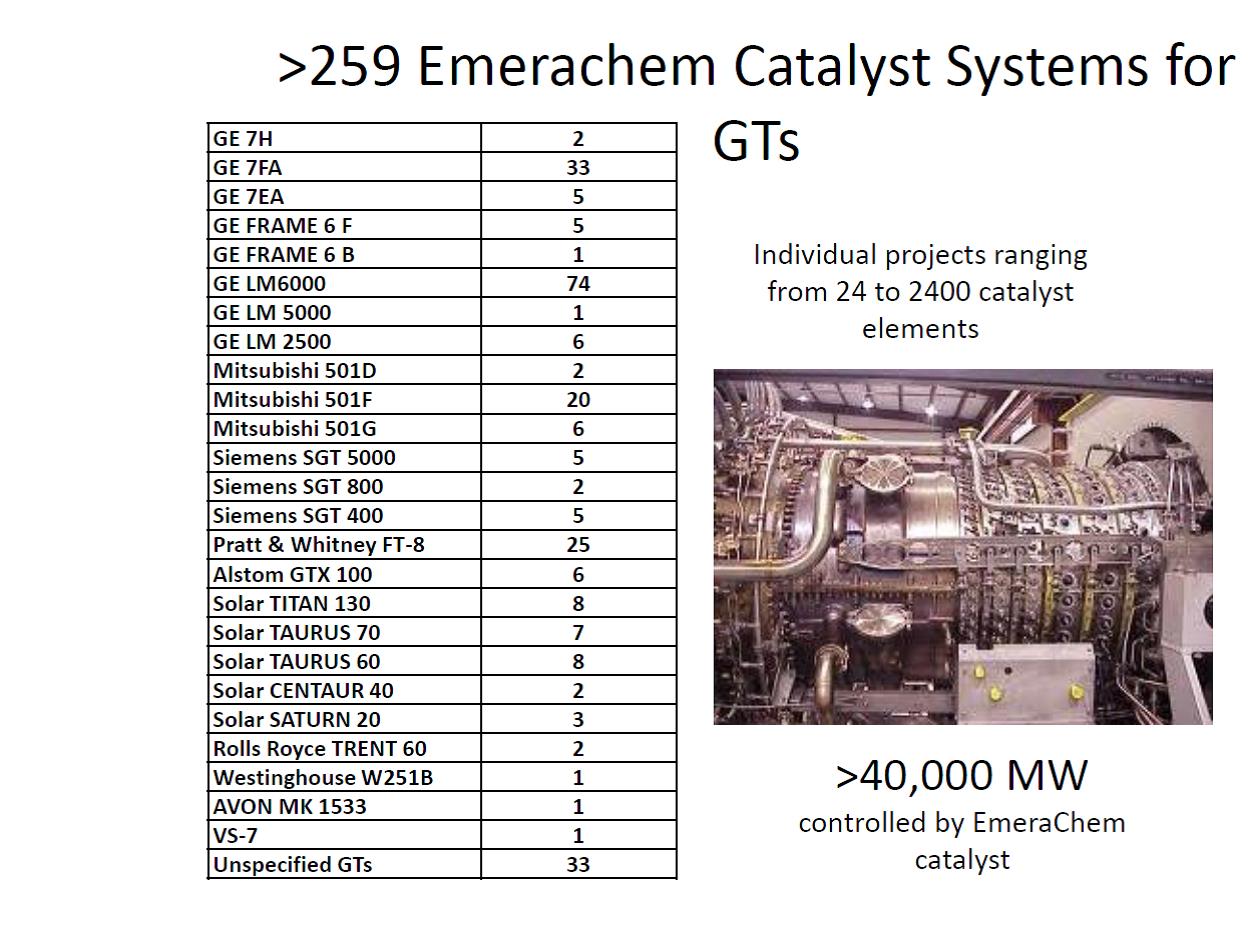
Haldor Topsoe
has a combination NOx and CO catalyst.
§
GT series SCR catalyst impregnated with active precious metal.
§
Controlled concentration and placement of active metal reduces undesirable side
reactions.
§
Truly “Dual Function Catalyst” DeNOx and oxidation of CO and VOCs.
§
Catalyst is not poisoned by SO2.
§
Extremely low SO2 oxidation,
5 to 10 times less than traditional Pt-based catalyst, less fouling.
§
Very low oxidation of ammonia, conversion mostly to nitrogen and water under
800°F.
§
Dual function solution provides lowest possible pressure drop. Generally
one-half of traditional solution.
§
With placement of catalyst downstream of ammonia injection, liquid ammonia
injection can be used.
§
Up to 95 percent DeNOx and 95 percent CO oxidation with very low ammonia slip.
§
Ammonia consumption increases on applications above 650°F.
§
References stand at 34 units sold, 4 are operational including two MHI 501G CCGT
in Texas.
Mitsubishi is a major supplier of SCR systems for gas
turbines with more than 600 installations. The company has combined with Hitachi
and is now Mitsubishi Hitachi Power
Systems (MHPS). The former Hitachi is a major supplier of catalysts. So
the new merged entity is supplying both catalyst and systems.
Modeling and Testing
Modeling has lots of
benefits. Air Flow Sciences
is providing both the modeling and subsequent testing services for clients in
Europe and Asia as well as the U.S.
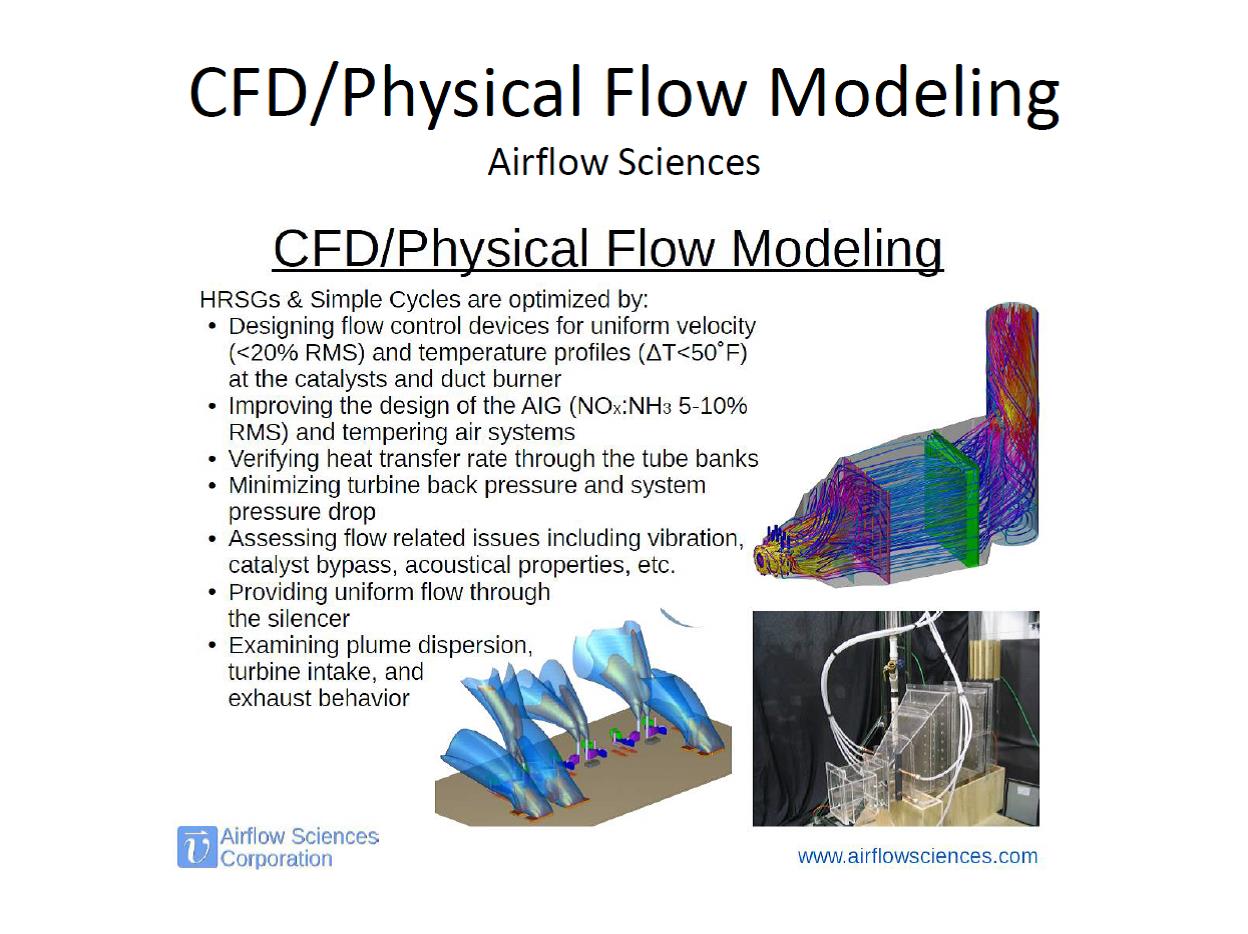
Breen
has developed an accurate way to determine SO3 at the HRSG.
Even though the levels are quite low the constant cycling creates
deposits on tubes. The net effect is to raise the flue gas concentration near
the tubes and therefore the acid dewpoint. The potential corrosion is of concern
and has sparked interest in the Breen analyzer.
Ammonia Injection
Wahlco
has been succcessful with their Ammonia on Demand or AOD process which provides
ways to convert urea to ammonia on site. There are two approaches, one for
smaller installations and one for larger ones.
The safety and availability of urea make it an attractive choice.
This
route map and summary is being posted in the gas turbine emission control and
exhaust system decision guide Gas Turbine Emission Control. This is a
protected site which is linked from the main website which is described in
59D Gas Turbine and Combined Cycle Decisions.
The
Decision system is organized to provide four knowledge needs: Alerts, Answers,
Analysis, and Advancement.
This
summary appears in the Gas Turbine Updates along with other new developments to
which users need to be alerted. Some of the more complete power point
presentations and papers submitted by the participants are being posted in the
database intelligence system to provide quick answers with the easy to use tier
system including subsidiary websites. The recording provides extensive analysis.
Future webinars will build on this one to provide additional analysis. The fact
that all the webinars are recorded makes it possible to work out very
comprehensive training (Advancement) programs.
The
entire August 6 recording can be heard at:
Gas Turbine Emission Control and Exhaust Systems
62 minutes
Hal Walls,
Clariant - Addendum
14 minutes
Speakers and participants in the Total Solutions Hot Topic
Hour on August 20 confirmed that customers want suppliers to offer a broader
scope of design and installation services. More operation and maintenance
support is also needed. Those companies offering a broad range of services
coupled with knowledge of the applications provide ways for the international
companies to eliminate local competition in developing countries.
An air polluter can buy components and design, operate and
service his pollution control system. Alternatively he can outsource all these
responsibilities. The revenue potential for all this outsourcing is defined as
the “Total Solutions Opportunity.”
The historical trend is toward greater and greater
outsourcing. The availability of new digital tools will accelerate this trend in
the future. This opportunity promises to deliver higher profits to suppliers and
lower life cycle costs and higher value products for operators. There are many
partial solutions as well as total solutions. Each needs to be evaluated.
McIlvaine stated that the reason operators need knowledge
and help is not because the experienced people are retiring but because
knowledge is growing exponentially and the human brain is not. A number of
the speakers offered other explanations. Leaner staffing by operators was one
explanation. Another was the perception that manufacturing jobs are not as
glamorous as software and electronics.
The need for broad-based
solutions is driven by a number of factors:
|
Factor |
Example |
|
Complex systems with
multiple control steps |
Coal-fired boilers, cement
kilns, chemical processes |
|
Valuable final product
recovery |
Precious metal mining |
|
Valuable process product
recovery |
Refinery catalyst, solvents
in chemical and surface treatment |
|
Difficult compliance with
air permit |
Many industries in many
countries where even start up and shut down
emissions are important. |
|
Safety |
Explosive gases |
|
Health |
Semiconductor toxic fumes |
|
Potential for air pollution
control system to negatively impact operations. |
Many industries |
|
Lack of skilled personnel
within the plant. |
Continuous trend |
|
Success of remote
monitoring |
Applicable to all
pollutants and operating parameters. |
|
Ability of suppliers to
provide a lower cost alternative. |
Reduction of repairs,
downtime, energy consumption, etc. |
The discussion involved a number of presenters and comments
from participants.
§
Clark
Griffith - Griffith Consulting,
has found success by providing all the customer needs from initial assessment to
installation and startup. Clark has an extensive background in thermal
oxidation. His services are available through the McIlvaine niche expert system.
§
Bruce
Galli - Marsulex, said
that the attractiveness of ammonium sulfate systems depends on the size of the
system e.g., more than 1.5 percent sulfur with flow equivalent to 200 MW to less
than 1,000 MW. The limitation on the high side is exceeding local demand
for ammonium sulfate.
§
Guisu Liu
- Mobotec, covered a range of
in furnace NOx and SOx reduction techniques.
§
John
Albritton - Paragon Air Heater,
explained the importance of air heaters relative to the size and performance of
downstream air pollution control equipment.
§
Martin
Schroter - Dürr, provided
details on the system using catalytic filters and powdered limestone injection
for cost-effective air pollution control and then heat and moisture recovery.
§
Rod
Gravely – Tri-Mer, also
discussed catalytic filters and the ability of his company to provide complete
turnkey systems. The system often competes with dry scrubbers followed by
conventional precipitators and SCR. Typically the Tri-Mer design is less costly
and takes 30 percent less space.
§
Tom Van
Remmen - Verantis, also
focused on complete turnkey systems. In some cases they are designing systems to
recover HCl and other valuable products. By offering a range of services they
have an international client base of companies such as BASF, Dow, and Eastman.
Tom says their business in China is down due to the lower level of activities of
international customers in the country.
§
Mike
Gregory - IAC, displayed
a new dry scrubbing system which uses a cyclone to minimize impact on a
downstream precipitator.
§
Craig
Thiry - Montrose, listed
a wide range of testing and consulting services available as a result of the
acquisition of 25 companies in recent years. Craig agreed that partnership with
turnkey system suppliers is a way to seamlessly provide what the customer needs.
§
Joe
Porcelli - Sulzer Chemtech,
described the static mixing technologies including the ammonia dispersion in the
flue gas stream.
The discussion was based on a series of power points
http://home.mcilvainecompany.com/images/Total_Solutions_8-21-2015.pdf
The full recording can be reviewed at:
Total Solutions
113 minutes
|
DATE |
UPCOMING HOT TOPIC HOUR |
UPCOMING MARKET UPDATES |
|
September 10, 2015 |
Power Plant Pumps |
|
|
September 11, 2015 |
Valve Market Forecast Changes |
|
|
September 24, 2015 |
Power Plant Water Monitoring
More information |
|
|
September 25, 2015 |
Pump Market Forecast Changes |
|
|
October 1, 2015 |
Power Plant Water Treatment Chemicals |
|
|
October 2, 2015 |
Fabric Filter Market Forecast Changes
|
|
|
October 22, 2015 |
Precipitator Improvements |
|
|
November 12, 2015 |
Dry Scrubbing |
|
|
December 3, 2015 |
NOx Reduction |
|
McIlvaine Company
Northfield, IL 60093-2743
Tel:
847-784-0012; Fax:
847-784-0061
E-mail:
editor@mcilvainecompany.com
Web site:
www.mcilvainecompany.com